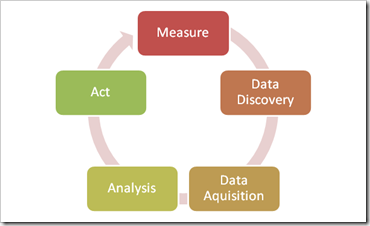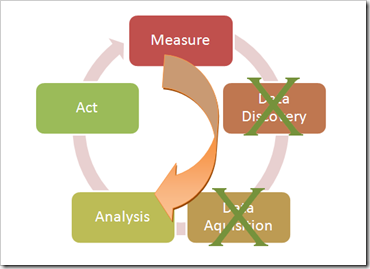One of the core characteristics of an analytical competitor is the ability to rapidly leverage the organization's data to make decisions faster than their competitors. Being first to market with a new idea, product or service will ensure success when the profit margins are high before the big new thing becomes a commodity.
Here is an example of a business using analytics to gain market share:
We need to retain our high end customers with a loyalty program. Who are our most profitable customers?
Our most profitable customers must be the ones that drive highest revenues, lets go and see what this customer base looks like.
Thus begins a cycle of analysis to answer this question.
- Data Discovery - What data is available on revenue? What systems contain this data? What is the quality and integrity of the data?
- Data Acquisition - Know that I know what data is available, how do we get it? Does it have to be brought into the Data Warehouse? Do I need to get an extract from the ERP system?
- Analysis - Looks like our highest revenue customers are large call centres...
- Act - Call these clients as the pilot group to offer them 5% off new equipment installs.
- Measure - Gather feedback from commercial account reps
Feedback comes in stating that many customers offered this discount said they would prefer more free support calls instead. What type of support call volume do we have anyway?
So begins another cycle of analysis to look at support call volume. If this data does not exist in a readily available source such as a Data Warehouse, then we have to go through the whole cycle starting with Data Discovery.

If we go through this again, we will likely lose at least days if not weeks until we are able to determine the next course of action on our journey to retain our most valuable customers. If a company is able to cut out the Data Discovery and Data Acquisition phases, they will be that much farther ahead of the competition.

Having high quality data that is available to decisions makers when they need it is essential to becoming an analytical competitor. Focus on building out a robust information architecture that contains data that is relevant to your business today. With this approach you will literally be two steps ahead of the competition.


 The capabilities of current BI tools allow us to drive down the costs to develop BI applications / data marts. This means that we can quickly develop tactical applications leveraging standard tools and methodologies to reduce development cycles. This enables the deployment of applications to support specific decision making problems that would normally not be supported by a quality BI environment due to the short turnaround required.
The capabilities of current BI tools allow us to drive down the costs to develop BI applications / data marts. This means that we can quickly develop tactical applications leveraging standard tools and methodologies to reduce development cycles. This enables the deployment of applications to support specific decision making problems that would normally not be supported by a quality BI environment due to the short turnaround required.
 Over the past year or so the "green" revolution has been sweeping IT as a way for organizations to reduce their environmental impact and to cut costs at the same time. This has driven the need for robust measurement systems to manage the transition to being a green organization. A number of the big BI vendors have come out with pre-packaged solutions to drive more "green" for organizations by encapsulating best practices.
Over the past year or so the "green" revolution has been sweeping IT as a way for organizations to reduce their environmental impact and to cut costs at the same time. This has driven the need for robust measurement systems to manage the transition to being a green organization. A number of the big BI vendors have come out with pre-packaged solutions to drive more "green" for organizations by encapsulating best practices.



 I recognize that I am a little behind the ball on predictions for the BI space in 2009. We are technically not a full month into the new year, so I'll sneak this in. I have to admit that I have had the opportunity to read a number of other posts on this topic, so I have late bloomer advantage. I'll focus on areas that I think will have a large impact on us all.
I recognize that I am a little behind the ball on predictions for the BI space in 2009. We are technically not a full month into the new year, so I'll sneak this in. I have to admit that I have had the opportunity to read a number of other posts on this topic, so I have late bloomer advantage. I'll focus on areas that I think will have a large impact on us all. One thing that has caught my attention over the past couple of months is the emphasis on new financial metrics in this depressed market. Employment statistics used to be mentioned in passing, and now we breathlessly await the monthly numbers. Clearly the global recession is an entirely new environment, and investors would be wise to not rely on old metrics and approaches to guide them.
One thing that has caught my attention over the past couple of months is the emphasis on new financial metrics in this depressed market. Employment statistics used to be mentioned in passing, and now we breathlessly await the monthly numbers. Clearly the global recession is an entirely new environment, and investors would be wise to not rely on old metrics and approaches to guide them. These are unsettling times, every family and every organization is looking closely at what they spend their money on, and the value they get from these expenses. In order to do this effectively, it all comes down to making sound decisions with the best possible information you can obtain. You wouldn't decide to change anything in your household, such as trading in your SUV for a Volkswagen without understanding all the angles such as financing, gas mileage, capacity, warranty, etc. Hmmm, decisions and information... sounds like a recipe for Business Intelligence!
These are unsettling times, every family and every organization is looking closely at what they spend their money on, and the value they get from these expenses. In order to do this effectively, it all comes down to making sound decisions with the best possible information you can obtain. You wouldn't decide to change anything in your household, such as trading in your SUV for a Volkswagen without understanding all the angles such as financing, gas mileage, capacity, warranty, etc. Hmmm, decisions and information... sounds like a recipe for Business Intelligence!


